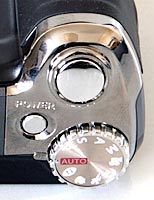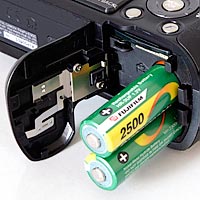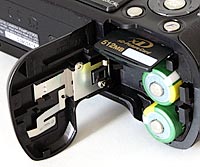Fujifilm Finepix E900 Review
Review Date: May 19th 2006
Leave a Comment about this Review
|
Ease of Use
The Fujifilm Finepix E900 isn't going to win too many awards for style, with a boxy, functional design finished in a black and grey colour-scheme. The E900 is largely constructed from plastic, with some rubberized areas around the handgrip area to aid handling. It actually has a very well thought-out design that feels intuitive to use as soon you pick it up. All of the major controls fall to hand and the chunky handgrip and rubber areas work very well together to ensure that you have a firm hold on the camera. At 10cms wide, 3.5cms deep and weighing 200g, the Fujifilm Finepix E900 isn't particularly compact, being most at home in a small camera bag.
The Fujifilm Finepix E900 has relatively few external controls, just 12 in total, which is surprising considering that this camera offers a full range of photographic controls. There's a traditional dial on the top of the camera that lets you select the different exposure modes; Program, Shutter Priority, Aperture Priority and Manual. This dial is a typical feature of SLR cameras, and enables you to quickly change between the various modes. The various Scene modes and the Movie mode are also accessed via this dial. You can directly access the various flash, aperture/shutter speed, macro and delete options by clicking on the four buttons around the navigation pad. As with most other Fujifilm digital cameras, the Fujifilm FinePix F11 has a Menu button on the rear of the camera which, as you would expect, gives you access to the software menu system. This lets you set various parameters including white balance, sharpness, focus mode and so on.
There's also a small silver button with an F on it, which opens what Fujifilm call the Photo Mode menu. This allows you to control the file quality setting, ISO speed and colour settings (B&W, Chrome or Standard). I'm not really sure why these 3 settings alone should fall under the heading of Photo Mode, and things like white balance are just part of the standard menu. And I'm undecided about whether it is a good idea or not. The F button does give quick access to certain features, but you do have to memorise what another button does. Alongside the F button is a completely unmarked button, which actually cycles through the various display options on the LCD screen (gridlines, information, thumbnails and off). Not being labeled in any way is initially a little confusing. The Fujifilm Finepix E900 has a nice pop-up flash unit which distances the flash from the lens and helps to avoid red-eye, but unfortunately this means that there is no AF Assist lamp available for low-light conditions.
| Shutter Release Button / Power Button / Mode Dial | Zoom Lever / Play Button / Navigation Pad / Display Button / Photo Mode Button |
 |
 |
If you have never used a digital camera before, or you're upgrading from a more basic model, reading the excellent 135 page manual before you start is a good idea. Thankfully Fujifilm have chosen to supply it in printed format, rather than as a PDF on a CD, so you can also carry it with you. The 2 inch LCD screen is a little disappointing, both in terms of size and the low number of pixels (just 115,000), but it does offer 100% coverage. There is also an optical viewfinder, something of a rarity there days, but sadly it has a couple of fundamental flaws. Firstly, when the lens is set to wide-angle, you can see the lens barrel in the bottom right-hand corner of the viewfinder. Secondly, it only offers 77% scene coverage, making accurate composition something of a point and hope affair.
The main menu system on the Fujifilm Finepix E900 is straight-forward to use and is accessed by pressing the Menu/OK button in the middle of the navigation pad. A vertical row of two tabbed pages along the left sided of the LCD screen represents the sub-menus, with 6 options in the first one one and 2 options in the second. At the bottom of the first tab is the Setup option - select this to access 4 more tabbed pages (containing 20 options in total) which contain options that you will probably set once and then forget about. Importantly, note that the RAW mode is turned on and off in this menu (not the most intuitive location). The various options and icons are fairly easy to read on the 2 inch screen.
The Fujifilm Finepix E900 offers a range of advanced exposure modes, including shutter-priority, aperture-priority and manual, perfect for the photographer who wants to take full control. The system used to actually set the aperture or shutter speed works well. In the two semi-automatic modes, you simply press up and down on the navigation pad to select an aperture/shutter speed. In the manual mode, you use up and down for the shutter speed, and also hold down the exposure compensation button if you want to change the aperture. A small vertical scale in the bottom right-hand corner of the screen indicates if the settings will result in an under or over exposed image. Simple and effective.
| Battery Compartment | Memory Card Slot |
 |
 |
The start-up time from turning the Fujifilm Finepix E900 on to being ready to take a photo is quick at around 1.5 seconds. Zooming from the widest focal length to the longest is also very snappy at around 1.5 seconds. Focusing is excellent in good light and the camera achieves focus most of the time indoors or in low-light situations, although it does struggle at the tele-photo end of the lens and there is no focus-assist lamp to help out. There is virtually no shutter-lag to speak of. The visibility and refresh rate of the 2 inch LCD screen is OK, although the low pixel count results in a slightly grainy display. It takes around 1 second to store a JPEG image, allowing you to keep shooting as they are being recorded onto the memory card - there is no LCD blackout after taking each image and the camera is immediately ready to shoot again. RAW images take longer to store, around 4 seconds, during which time you can't take another photo. This is an improvement on previous compact digicams that have offered the RAW format, but it's still annoying enough to limit you to photos of still subjects. The Fujifilm Finepix E900 has a very poor Continuous mode which enables you to take 1.5 frames per second at the highest JPEG image quality, up to a maximum of 4 images. Overall the Fujifilm Finepix E900 is above average in terms of operational speed.
Once you have captured a photo, the Fujifilm Finepix E900 has a good range of options when it comes to playing, reviewing and managing your images. You can scroll through the images that you have taken, view thumbnails, zoom in and out (although note that this is very slow), sort images by date, view slideshows with lots of different settings, delete, protect, trim and rotate an image. You can also add a sound clip to an image, set the print order and the transfer order. The Exposure Compensation button toggles detailed settings information about each picture on and off, such as the ISO rating and aperture/shutter speed, including a small histogram.
The Fujifilm Finepix E900 is an intuitive, mid-sized, responsive digital camera which offers a wealth of creative shooting opportunities. Weak points include the optical viewfinder, low resolution LCD screen, slow RAW mode and lack of focus-assist lamp.
|
![]() PhotographyBLOG
is a member of the DIWA
organisation. Our test results for the Fujifilm Finepix E900
have been submitted to DIWA
for comparison with test results for different samples of
the same camera model supplied by other DIWA
member sites.
PhotographyBLOG
is a member of the DIWA
organisation. Our test results for the Fujifilm Finepix E900
have been submitted to DIWA
for comparison with test results for different samples of
the same camera model supplied by other DIWA
member sites.
